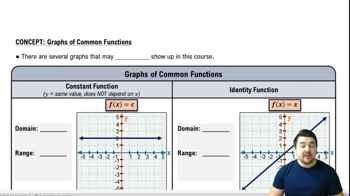Table of contents
- 0. Review of College Algebra4h 43m
- 1. Measuring Angles39m
- 2. Trigonometric Functions on Right Triangles2h 5m
- 3. Unit Circle1h 19m
- 4. Graphing Trigonometric Functions1h 19m
- 5. Inverse Trigonometric Functions and Basic Trigonometric Equations1h 41m
- 6. Trigonometric Identities and More Equations2h 34m
- 7. Non-Right Triangles1h 38m
- 8. Vectors2h 25m
- 9. Polar Equations2h 5m
- 10. Parametric Equations1h 6m
- 11. Graphing Complex Numbers1h 7m
0. Review of College Algebra
Functions
Problem 81
Textbook Question
Textbook QuestionDetermine the intervals of the domain over which each function is continuous. See Example 9.
 Verified Solution
Verified SolutionThis video solution was recommended by our tutors as helpful for the problem above
Video duration:
2mPlay a video:
Was this helpful?
Key Concepts
Here are the essential concepts you must grasp in order to answer the question correctly.
Continuity of Functions
A function is continuous at a point if the limit of the function as it approaches that point equals the function's value at that point. For a function to be continuous over an interval, it must be continuous at every point within that interval. This concept is crucial for determining where a function does not have breaks, jumps, or asymptotes.
Recommended video:

Graphs of Common Functions
Types of Discontinuities
Discontinuities can be classified into three main types: removable, jump, and infinite. A removable discontinuity occurs when a function is not defined at a point but can be made continuous by defining it appropriately. Jump discontinuities happen when the left-hand and right-hand limits at a point do not match, while infinite discontinuities occur when a function approaches infinity at a certain point.
Recommended video:

How to Use a Calculator for Trig Functions
Interval Notation
Interval notation is a mathematical notation used to represent a range of values. It uses brackets [ ] to include endpoints and parentheses ( ) to exclude them. Understanding interval notation is essential for expressing the domain of continuity for functions, as it succinctly conveys which intervals are valid for the function's continuity.
Recommended video:

i & j Notation

 5:2m
5:2mWatch next
Master Introduction to Relations and Functions with a bite sized video explanation from Nick Kaneko
Start learningRelated Videos
Related Practice






